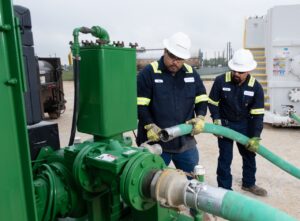How To Ensure You Rent The Right Pump For Your Job
Whenever a large amount of water needs to be moved unexpectedly and/or on a temporary basis, the answer is usually to rent a pump. Renting a pump seems like it should be a simple process. Unfortunately, the type and size of pump that is needed depends heavily on a range of factors. In many cases, complications such as challenging geography, difficult or contaminated fluid, and limited space may require a fluid engineer to select or design a special solution. Using the wrong rental pump or employing a poorly designed solution can cause unexpected or unnecessary costs, project delays, and downtime. Here’s how to determine the right rental pump for a given project.
Questions To Ask
Before choosing a rental pump, ask these five questions:
- What are you pumping? Most rental situations only involve moving water, but anything flammable, corrosive, or viscous may require specific solutions. The pump must be physically and chemically compatible with what is being pumped.
- Are there solids in the liquid? Different pump types can handle different levels of solids and volumes of grit. However, typical rental pumps cannot be used to move sand and gravel.
- What is the temperature? Most pumps can handle a wide range of fluid temperatures, but the average pump won’t accept cryogenic fluids or liquids near the boiling point.
- How many hours per day will the pump be operating? There is a significant difference in the fuel consumption and maintenance requirements for a pump expected to run for an eight-hour workday versus one that will run 24-hours a day for several days.
- What is the Total Dynamic Head (TDH) requirement of this pumping system? TDH is a measurement of a pump’s lifting capacity. It is calculated using flow rate, discharge pressure, vertical and horizontal distance of the pump from the liquid and to the point of discharge, and more. If the project manager does not know how to calculate TDH, it is best to work with a pump vendor who can.

Ironclad Environmental employees attach rental hoses to a pump at a jobsite.
Most Common Rental Pumps
Before choosing a pump, it is important to know what types of pumps are available and the most common applications for them.
- Air operated diaphragm pump. Ideal for flammable and corrosive liquids, these pumps use positive displacement to move fluids and are powered by compressed air or nitrogen. They are also ideal for pumping in Class 1 Div 1 atmospheres (in which inflammable gases or vapors may be present) or in confined spaces where diesel fumes could be problematic.
- High-head prime assisted pump. Specifically for projects involving high TDH, these pumps are meant to move water long distances or great vertical distances. It’s important that these pumps not be used in low TDH applications, as doing so could cause cavitation, damaging the pump and incurring costs and downtime.
- Prime-assisted trash pump. The most common type of pump, trash pumps can be used in the wideset range of projects. However, it is critical to use the right size pump to avoid wasting fuel or potentially damaging the pump. The proper size is determined by the flow rate, viscosity, and more. Project managers should also keep in mind how consistent the flow rate will be (peaks and valleys).
- Sound attenuated pump. Many applications require a pump that produces significantly less noise. This is typically for projects taking place in or around hospitals, schools, or communities with noise ordinances. For example, for a sewer bypass, the pumps will likely be running 24 hours a day, including at night while residents are sleeping.
- Stainless steel trash pump. A hardier version of a common trash pump, these are ideal for projects involving corrosive or abrasive liquids. The harder CD4MCu steel materials will work on a range of acidic materials (except hydrochloric acid or sulfuric acid). It can also handle water with high levels of suspended solids. Of course, stainless steel pumps are not impervious and project managers should discuss the level and type of grit that may be present before renting.
Putting It All Together
While many applications may seem obvious, the best way to ensure the right pump is selected for a given project is to work with the vendor. Moreover, project managers should seek a vendor that has the highest level of expertise. The technical team should have a background in technology and engineering as well as experience with similar problems or projects.
Beyond expertise, the right vendor should do more than just rent pumps. Sales and technical staff should visit the job site, double check measurements, and provide a complete solution design, including pipes, fittings, clamps, and other technologies that may be required. Overall, collaboration with knowledgeable vendors who can offer expertise, comprehensive solution design, and onsite support is crucial for overcoming challenges and ensuring the success of fluid management projects.